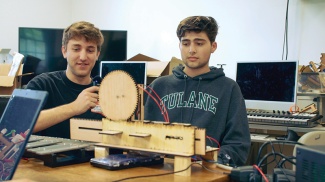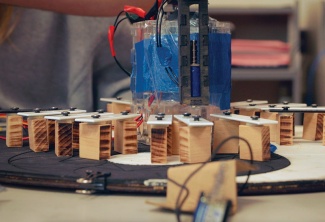Tucked away in a classroom in Dixon Hall, a chorus of whirring motors and ringing xylophones accompanies the chatter of students as they work through the trial-and-error process inherent to robotics. This is Algorithmic and Computer Music, a course led by Rick Snow, senior professor of practice of Music Science and Technology in the School of Liberal Arts. In this class, groups of students combine musical and engineering concepts to create musical robots.
“With every change in technology throughout human history, it has somehow been applied to music,” said Snow. He views the musical robots his students create as a natural next step in a tradition of wind-up music boxes and musical automata.
Snow has previously worked with engineering students to create musical robots for their capstone projects, but this is the first class on the subject available to non-engineering students.
“I can tailor the class to the interests of the students who want to take it,” said Snow.































































